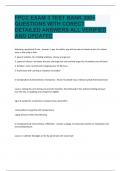FPCC EXAM 3 TEST BANK 300+
QUESTIONS WITH CORECT
DETAILED ANSWERS ALL VERIFIED
AND UPDATED
Selecting a peripheral IV site - Answer-1. age- for adults, you will use veins in hands or arm; for infants
veins in the scalp or foot
2. type of solution- for irritating solutions, choose a large vein
3. speed of infusion- the faster the rate, the larger the vein and the larger the IV catheter you will need
4. duration- some recommend changing every 72-96 hours
5. avoid areas with scarring or impaired circulation
IV complications & interventions: hematoma - Answer-localized mass of blood outside the blood vessel
causes: nicking the vein during unsuccessful insertion, discontinuing IV line without holding pressure
over the site, or applying a tourniquet too tightly
signs & symptoms: ecchymosis, localized mass, discomfort
-Interventions: be gentle with venipuncture
-apply pressure when discontinuing
IV complications & interventions: infiltration - Answer-seepage of novesicant solution or medication into
surrounding tissues
causes: iv catheter dislodges or the tip penetrates the vessel wall
,signs & symptoms: slowed or stopped flow, swelling, tenderness, pallor, hardness and coolness at the
site. pt may report a burnt sensation
-stop immediately
-restart in a different vein, higher in extremity or another extremity
IV complications & interventions: extravasation - Answer-seepage of a vesicant substance into the tissues
(vesicant- causes blisters)
iv catheter dislodges or tip penetrates vessel wall
signs & symptoms: slowed or stopped flow, pain burning & swelling at site, blanching & coolness.
blistering is a late sign.
if extravasation resulted from vasoconstricting medication may see necrosis of dermis
-treatment depends on severity
-stop immediately
-administer antidote
-apply cold compress, elevate extremity
IV complications & interventions: phlebitis - Answer-inflammation of the vein
causes: may be due to mechanical irritation, infusion of solutions that are irritating to the vessel, or
sepsis
dextrose solutions, potassium chloride, antibiotics, and vit. c are associated with higher risk
trauma to the vessel, compression of the line by client movement, or low flow rate
signs & symptoms: redness, pain, warmth at site, swelling, palpable cord along the vein, sluggish infusion
rate, elevated temp. slowed or stopped infusion, inability to restart flow of iv
,-discontinue IV & restart in new location
-apply cold compress initially if site is warm & tender. then apply warm compress
IV complications & interventions: thrombophlebitis - Answer-thrombosis & inflammation
causes: use of veins in leg for infusion, use of hypertonic or highly acidic solution, can be a result of
untreated phlebitis
signs & symptoms: sluggish flow rate, edema, tender & cord-like veins, warmth, & erythema at site
-discontinue IV infusion, restart in opposite extremity w/ new equipment
-apply warm compress
-consult provider
IV complications & interventions: local infection - Answer-causes: poor technique when inserting, leaving
in place longer than 96 hours, or direct contamination
signs & symptoms: redness, swelling, exudate, elevated temp
-remove IV line
-apply sterile dressing over site
-administer antibiotics if necessary
IV complications & interventions: nerve injury - Answer-causes: using inner surface of wrist & forearm;
not anchoring the vein for puncture; using a large needle; advancing the needle across instead of with
the vein; inserting too deeply
signs & symptoms: direct injury- sharp acute pain at the site or up and down the arm; pins and needles
or electric shock sensation
compression injury- pain & tingling typically appear 24-96 hours after venipuncture
, -do not make more than 2 attempts
if pt complains of symptoms:
-stop procedure & withdraw catheter
-apply pressure to prevent hematoma
-report to supervisor
-do not start a new IV in affected arm
-treat infiltration if it occurs
IV complications & interventions: septicemia - Answer-presence of microorganisms or their toxic
products in the circulatory system
causes: break in aseptic technique, contaminated IV solution
signs & symptoms: fluctuating fever, chills, tachycardia, confusion, hypotension, altered mental status,
elevated WBC
-discontinue iv infusion immediately
-consult provider
-treatment often involves antibiotics, fluids, & meds to support vitals
IV complications & interventions: fluid overload - Answer-cause: infusing excessive amounts of IV fluids
or administering fluids too rapidly
signs & symptoms: weight gain, edema, hypertension, shortness of breath, crackles, distended neck
veins
-slow IV rate
-place client in high fowlers




